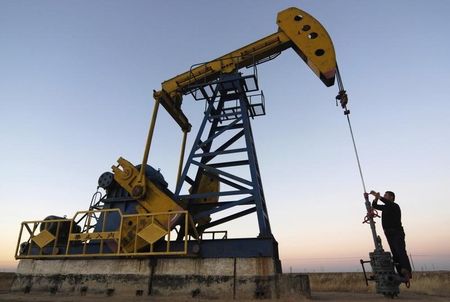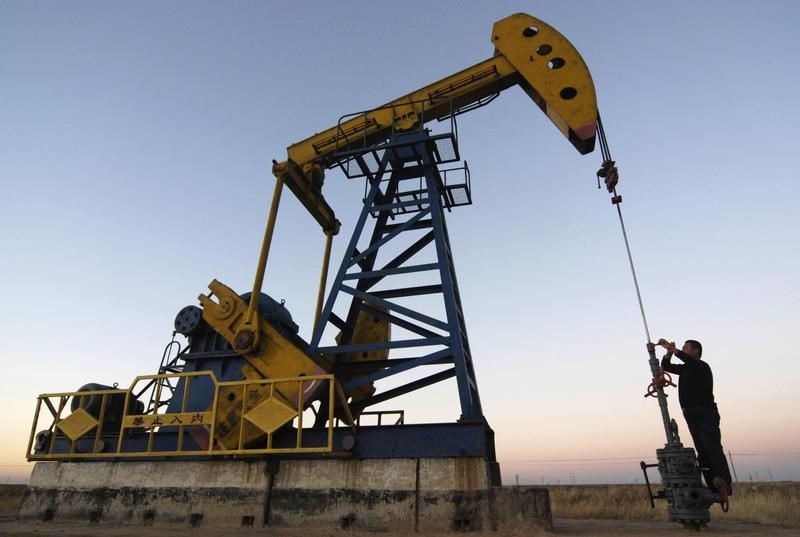Commodities
Crude oil higher; Saudi Arabia, Russia cut output levels


© Reuters.
Investing.com — Oil prices received an unexpected boost Monday, after top exporters Saudi Arabia and Russia announced supply cuts for August, overshadowing concerns over slowing economic activity.
By 09:35 ET (13:35 GMT), futures traded 0.3% higher at $70.84 a barrel, while the contract rose 0.3% to $75.62 a barrel.
Top exporters reduce supplies
Saudi Arabia announced earlier Monday that it would extend its voluntary cut of one million barrels per day to also include August, while Russia also stated it will reduce its oil exports by 500,000 barrels per day in August.
The cuts amount to 1.5% of global supply and bring the total pledged by the OPEC+ oil producers to 5.16M barrels per day.
Saudi Arabia, the de facto leader of the Organization of Petroleum Exporting Countries, has been trying to prop up prices, which are still over 11% lower so far this year on concerns of an economic slowdown.
Disappointing PMI data
More evidence of the global economic slowdown emerged earlier Monday, with data showing eurozone manufacturing activity contracted faster than initially thought in June.
The final eurozone fell to 43.4 from May’s 44.8, its lowest since the COVID pandemic was cementing its grip on the world, below a preliminary reading of 43.6 and further from the 50 mark separating growth from contraction.
The Chinese data was slightly better than expected, with the reading 50.5 for June, higher than expectations for a reading of 50.2.
However, this was still slower than the prior month’s reading of 50.9, and contrasts with last week’s official survey which showed that China’s manufacturing activity contracted for a third straight month in June.
Non-policy OPEC meeting this week
The move by the Saudi and Russian governments to cut supplies has taken the shine off a meeting of oil industry executives with energy ministers from the Organization of Petroleum Exporting Countries and allies later this week.
While the forum is not a policy meeting, meaning that any changes to OPEC production are unlikely, it is still expected to offer cues to the oil market, amid growing fears of worsening demand this year.
Net long positions reduced
This uncertainty surrounding the likely slowing in demand growth as well as supply levels has been reflected in the latest positioning data, which shows that speculators reduced their net long positions in both the ICE Brent and NYMEX WTI contracts over the last reporting week.
“This was driven by a combination of longs liquidating and fresh shorts entering the market,” said analysts at ING, in a note, with the numbers resulting in “the smallest net long speculators have held in WTI since March when we saw prices trading briefly below US$65/bbl.”
Commodities
Oil prices rise; U.S. crude inventories plunge, Russia-Ukraine truce eyed
Commodities
India’s Reliance to stop buying Venezuelan oil over US tariffs, sources say
Commodities
Oil prices climb on Venezuela supply worries

 Forex3 years ago
Forex3 years agoForex Today: the dollar is gaining strength amid gloomy sentiment at the start of the Fed’s week

 Forex3 years ago
Forex3 years agoUnbiased review of Pocket Option broker

 Forex3 years ago
Forex3 years agoDollar to pound sterling exchange rate today: Pound plummeted to its lowest since 1985

 Forex3 years ago
Forex3 years agoHow is the Australian dollar doing today?

 Cryptocurrency3 years ago
Cryptocurrency3 years agoWhat happened in the crypto market – current events today

 World3 years ago
World3 years agoWhy are modern video games an art form?

 Commodities3 years ago
Commodities3 years agoCopper continues to fall in price on expectations of lower demand in China

 Economy3 years ago
Economy3 years agoCrude oil tankers double in price due to EU anti-Russian sanctions



























